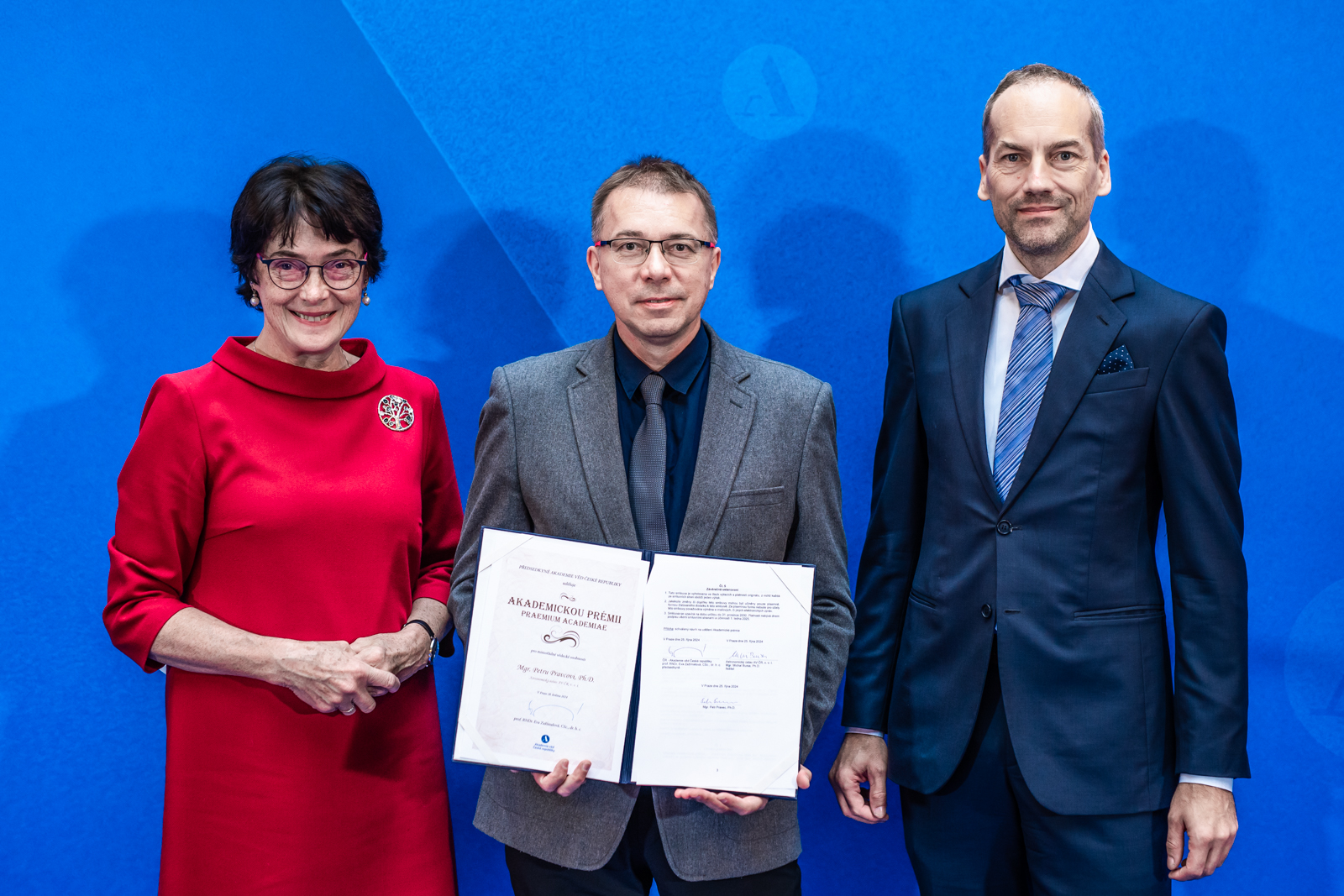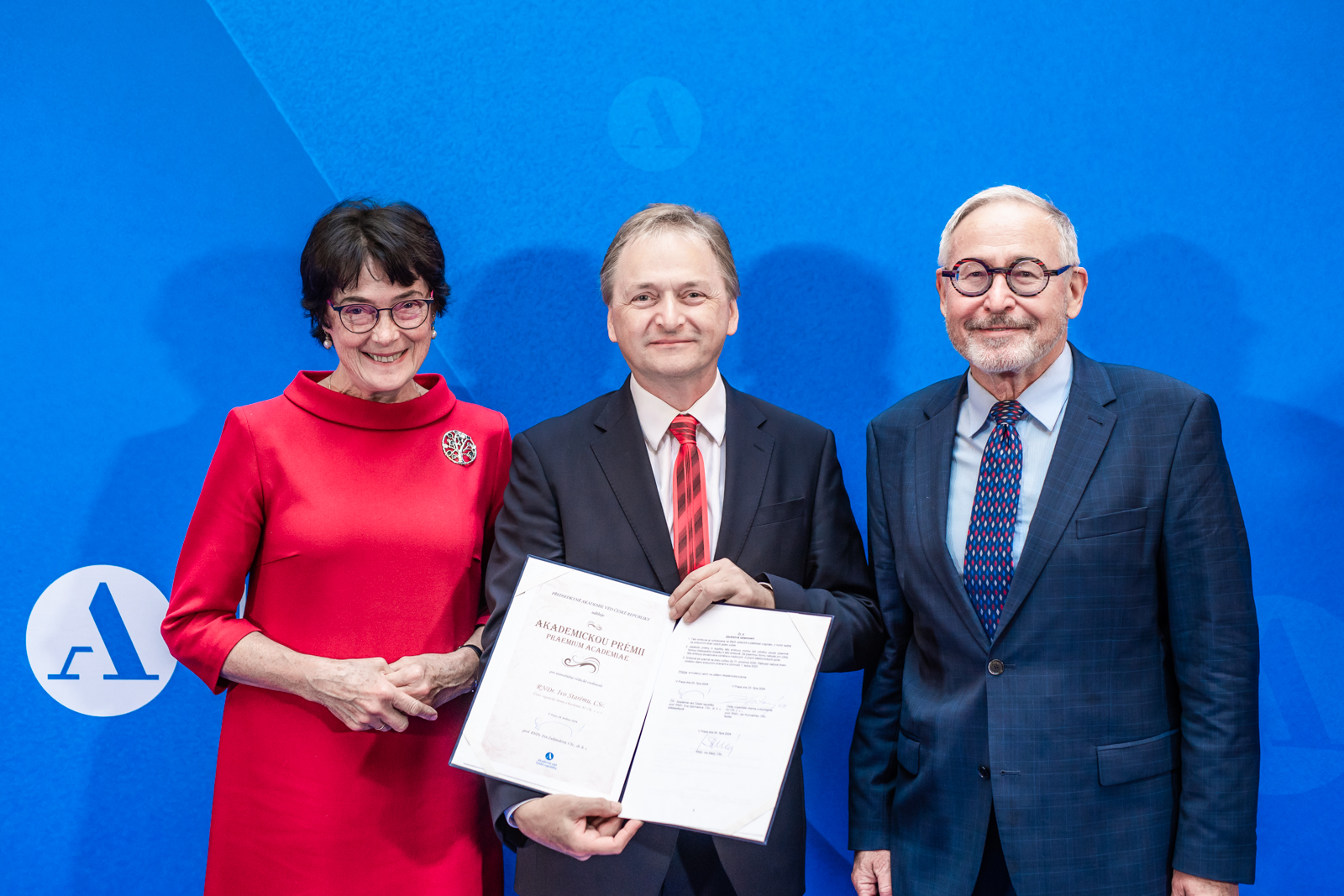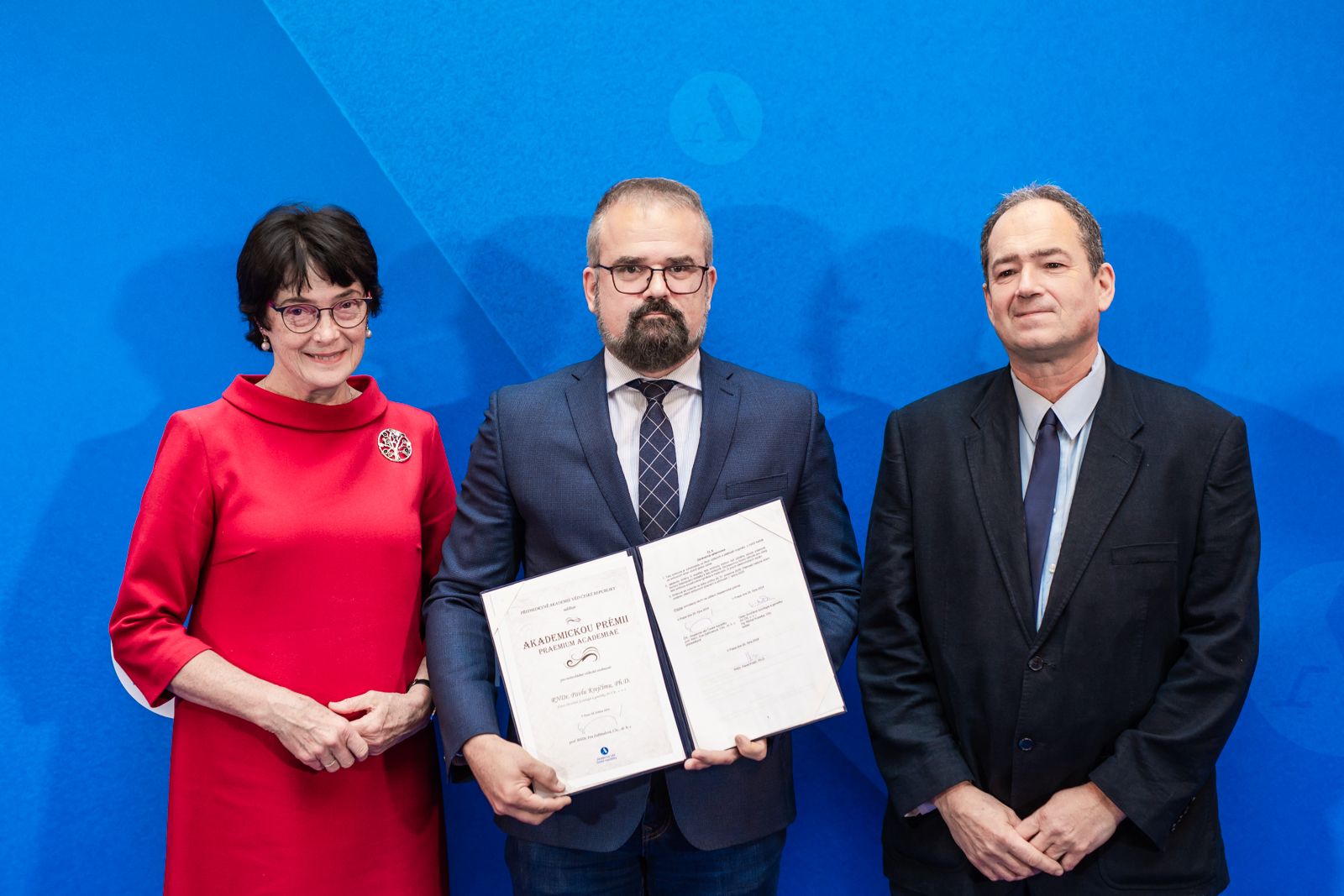
CAS researchers received the 2024 Praemium Academiae and Lumina Quaeruntur
29. 10. 2024
Space, fungi, and European languages – nine researchers from the Czech Academy of Sciences (CAS) were awarded for their contributions across diverse fields of study. At a ceremony held on 25 October 2024, three of these scientists received the Praemium Academiae from CAS President Eva Zažímalová, while six were awarded the Lumina Quaeruntur grant. The awards constitute financial support for their ongoing research.
This year, the awards were presented jointly, which CAS President Eva Zažímalová sees as symbolic. “These are our most prestigious research support awards. They assist experienced scientists who have achieved remarkable results in their field, as well as promising researchers, whom we want to empower to accomplish great things,” Zažímalová noted.
The two CAS awards help scientists establish optimal conditions with minimal bureaucratic hurdles, which often accompany standard grant processes. “Johann Wolfgang von Goethe once said that ‘knowing is not enough; we must apply. Willing is not enough; we must do.’ Our awarded researchers unquestionably are knowledgeable and willing. But to apply themselves, they need funding,” Zažímalová added.

The 2024 laureates of the Academic Award – Praemium Academiae and the Lumina Quaeruntur with the CAS President, Eva Zažímalová.
The Praemium Academiae awards were presented to Petr Pravec from the Astronomical Institute of the CAS, Ivo Starý from the Institute of Organic Chemistry and Biochemistry of the CAS, and Pavel Krejčí from the Institute of Animal Physiology and Genetics of the CAS. Over the next six years, they are eligible to draw up to CZK 30 million to cover research expenses, salaries, and technical equipment.
Astronomical achievements within reach
Petr Pravec has achieved extraordinary success studying asteroids that pass near Earth. These asteroids are a valuable source of information for understanding processes in our Solar System and could even serve as a potential resource. However, they could also pose a threat to Earth in regard to potential impact.
Pravec has discovered or co-discovered several hundred asteroids and their moons, one of which was the satellite of the Didymos asteroid, later chosen by NASA for its Double Asteroid Redirection Test (DART) mission – a trial of technology for deflecting dangerous asteroids from Planet Earth. Pravec’s team played a crucial role in this mission, marking one of the greatest achievements in Czech astronomy. Over the next six years, the Czech astronomer plans to study potentially hazardous asteroids approaching Earth. “I hope we can achieve similarly excellent, or even better, results as we did with DART,” he said.

Petr Pravec (center).
A lab poised for world-class science
Ivo Starý specializes in organic chemistry, catalysis, chirality, and nanoscience. With his team, he explores areas of organic chemistry that overlap with physics and biology. “Our aim is to ‘outsmart’ nature by designing molecular structures it doesn’t know but that might prove useful, for instance, in technology,” Starý stated. At the Institute of Organic Chemistry and Biochemistry of the CAS, he leads a group focused on functional molecular chemistry, innovating in the study of chiral molecular structures and their physical-chemical and material properties.

Ivo Starý (center).
The Academic Award will enable the group to embark on interdisciplinary projects. Having already gathered valuable insights, the funding will allow the IOCB lab to soon join the ranks of world leaders in their field.
Understanding growth disorders
In the Czech Republic, 4–5 children are born annually with achondroplasia – the most common genetic bone growth disorder, which results in short stature and associated health issues. For Pavel Krejčí, achondroplasia is a “laboratory” that can help us better understand intercellular communication.
With over 20 years of research on growth factors critical for cell communication, Krejčí has established a clinical registry for patients with achondroplasia and contributed to developing treatments for this disorder. The first of these treatments has been available to Czech children since 2022, and another is in clinical trials in Japan. “Our success is the result of hundreds of people’s work worldwide,” Krejčí emphasized.

Pavel Krejčí (center).
With the Praemium Academiae, he aims to delve deeper into cellular communication mechanisms by means of eight specific projects, including the development of new treatments for growth disorders.
Praemium Academiae as financial and moral support
The Academic Award is used as a tool for offering funding and moral support to excellent CAS researchers in order to develop their potential. The amount of the premium (up to CZK 30 million) can be used by the recipients over the following six years to pay for technical equipment, salaries, and research costs. The Praemium Academiae has been awarded by the CAS since 2007; the list of laureates can be found on the CAS website.
*
Supporting talent and exceptional achievements
The Lumina Quaeruntur fellowship targets mid-career scientists, including those returning from parental leave, to help them establish their own research groups. The award provides up to CZK 4 million per year for a maximum of five years, with at least 20% of the budget contributed by the researcher’s affiliated institution.
This year’s recipients include Masafumi Imai from the Institute of Atmospheric Physics of the CAS, Ivo Šulák from the Institute of Physics of Materials of the CAS, Danny Haelewaters from the Biology Center of the CAS, Vít Hubka from the Institute of Microbiology of the CAS, Vladislav Knoll from the Institute of Slavonic Studies of the CAS, and Jan Vondráček from the Masaryk Institute and Archives of the CAS.
The atmosphere of Jupiter
Our knowledge of Jupiter’s atmospheric phenomena, including those associated with radio emissions, remains limited. According to Masafumi Imai, we don’t yet know if radio emissions tied to Jupiter’s auroras vary throughout its orbit around the Sun, nor do we have a full understanding of where lightning is most prevalent on the planet.
Imai’s team will seek answers to these and other questions. They also aim to assist in measurements with the new JUICE probe mission, set to arrive at Jupiter and its icy moons by 2031. Imai focuses on lightning signals from Jupiter’s atmosphere and has co-authored the largest catalog of lightning on the planet. He sees the planet’s polar regions and atmosphere as sources of intense radio waves, believing this research could yield insights into the structure of Jupiter’s auroras and variations in its storm activity.
Superalloys for next-generation power plants
The team of Ivo Šulák aims to develop composite nanomaterials based on superalloys which will be usable for future hydrogen power plants, such as high-pressure turbine blades. These superalloys hold promise not only for next--generation power plants, but also for the aerospace industry.
Achieving high temperatures is crucial for enhancing engine efficiency. If materials that withstand extreme heat and the harsh conditions within engines can be developed, fuel consumption and CO₂ emissions could be reduced. “The feeling you have as a kid taking apart your dad’s car models, sometimes not being able to put them back together, is one you sometimes experience in science too,” Šulák explains, motivated by a desire to understand why things happen as they do.
Evolution and biodiversity
Belgian mycologist Danny Haelewaters focuses on multi-trophic symbiosis, consisting of relationships at multiple levels of the food chain. His team’s biodiversity monitoring project will study symbiosis between bats, the flies living on them, and the fungi that parasitize these flies.
According to Haelewaters, interactions across these trophic levels are key to microevolutionary processes, as they lead to evolutionary isolation and the development of distinct species. His research will also examine climate change disruptions and what happens when one symbiotic partner goes extinct.
The Lumina Quaeruntur Award will help Haelewaters fulfill a long-time dream from his doctoral studies – founding his own laboratory. His team also hopes to build a complete “tree of life” for fungi, mapping the evolutionary pathways and branching of different fungi species over time. Haelewaters is optimistic about discovering previously unknown species, especially in places like Papua New Guinea.
Exploring the world of fungi
Vít Hubka will establish a research team at the CAS focused on medical mycology, particularly the study of filamentous fungi. His work will cover emerging zoonotic fungi causing skin infections in humans as well as opportunistic fungal infections that pose serious threats to immunocompromised individuals.
Hubka aims to bridge the clinical and veterinary fields to improve prevention of fungal transmission from pets to humans and increase awareness of these pathogens. “I’m looking forward to five years full of exciting, productive results,” he says.
He has already introduced a simplified system for classifying certain Aspergillus species, impacting both infection diagnostics and food safety. A newly identified species that causes lung disease has even been named in his honor: Aspergillus hubkae.
Languages against the current
The linguistically gifted researcher Vladislav Knoll recalls, “Just nine years ago, I wouldn’t have dreamed of being in academia, let alone working at the Czech Academy of Sciences.” Now, he researches the history of Church Slavonic, historical sociolinguistics, and is the author of a book on the West Slavic language, Kashubian. His publication, the only one of its kind, has become a major reference in studies on Kashubian history and German–Slavic linguistic contact.
The Lumina award will enable Knoll to establish a team at the Department of Paleoslavonic Studies and Byzantine Studies to investigate the formation of written languages in medieval and early modern Europe, fostering international collaboration.
Digitizing history for greater insight
Jan Vondráček focuses on World War II history and the daily life and political administration of the Protectorate of Bohemia and Moravia. His team is developing new methods for digital humanities in partnership with specialists from the Massachusetts Institute of Technology (MIT), creating software that connects and analyzes digitized historical sources with the help of artificial intelligence.
This software integrates digitized decrees, laws, official protocols, and letters, offering translation and AI services. The scientists’ ambition is to make this software widely accessible and connected with archives, libraries, and institutions worldwide. Vondráček’s team will focus on digital technologies and AI in the context of historical sciences. Vondráček received limited support in his native Germany, so he appreciates the opportunity to bring his vision to life at the Czech Academy of Sciences.
For more information on the Lumina Quaeruntur, please visit the CAS website.
Prepared by: Zuzana Dupalová, External Relations Division, CAO of the CAS, drawing on the press release issued by the CAS
Translated by: Tereza Novická, External Relations Division, CAO of the CAS
Photo: Jana Plavec, External Relations Division, CAO of the CAS
 The text and photos are released for use under the Creative Commons license.
The text and photos are released for use under the Creative Commons license.
Read also
- Renewables are a strategic investment in European security, scientists say
- New record set for neutrino mass: one million times less than an electron
- On the trail of the endangered little owl: searching for newly hatched owlets
- Teen scientist breaks barriers: No child is a lost cause
- The Czech Academy of Sciences has appointed its new leadership for 2025–2029
- Literature is tied to its historical context. How can we read between the lines?
- Radomír Pánek: The Academy must be united, strong, and proactive
- A springtime booster: The healing potential of tree buds
- A novel compound that protects bone cells may benefit diabetic patients
- New interactive exhibition at the CAS showcases materials shaped by genius ideas
The Czech Academy of Sciences (the CAS)
The mission of the CAS
The primary mission of the CAS is to conduct research in a broad spectrum of natural, technical and social sciences as well as humanities. This research aims to advance progress of scientific knowledge at the international level, considering, however, the specific needs of the Czech society and the national culture.
President of the CAS
Prof. Eva Zažímalová has started her second term of office in May 2021. She is a respected scientist, and a Professor of Plant Anatomy and Physiology.
She is also a part of GCSA of the EU.



















